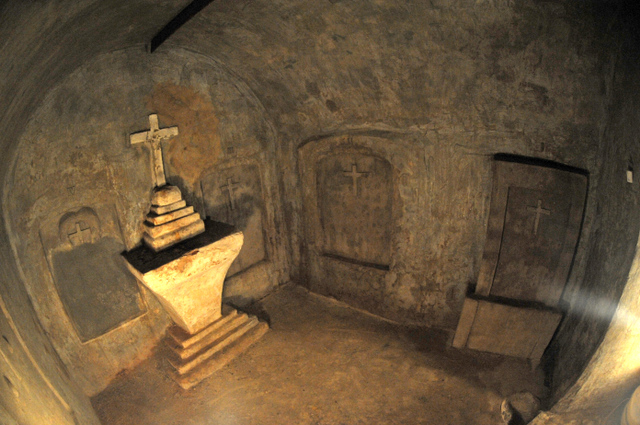Rails from the Crypt
Santa Barbara Mission Opens Burial Chamber for Repair Work

On Monday morning, just a day after jam-packed Easter services filled the pews, a different kind of joyous noise was buzzing inside Mission Santa Barbara’s usually quiet church, as a construction crew began a project to fix and find out more about the historic crypt located beneath the adobe tile floor.
Expected to be complete in five days, the work is primarily being done to strengthen the crypt’s entranceway, where the stone grave marker and adjacent tiles were previously supported a century ago by the installation of steel rails, presumably sourced from the street trolley line that once ran outside. Since the crypt is frequently damp, those rails have corroded, causing concern for visitors’ safety, so they will be replaced with identical but modern and specially coated steel rails. Additionally, the crew from Channel Coast Corporation will install a ventilation system to cut down on that dampness, put in sensors to track both temperature and moisture, and analyze the concrete walls to see if future repairs should be made to them.
“We’re using the opportunity to study the feature as well as do the important repair work,” said the mission’s museum director Kristina Foss, who said that the work should cost around $50,000 “if we don’t have any surprises.” The project, which is being facilitated in large part by the California Missions Foundation, is being paid for by a grant from the National Park Service’s Save America’s Treasures program, with additional support from the Santa Barbara, Bechtel, and Hearst foundations. Because the mission is a national landmark, all of the work must be done according to strict design codes, and those strictures are all the more important in this case, because having a burial chamber located within a mission church is thoroughly unique.
“It’s the only crypt in any California mission, whether in Alta or Baja California,” explained Foss, who believes that it was originally constructed during one of the post-earthquake rebuilds of 1812 or 1820, though can’t be entirely sure because the records from those years are incomplete. Back then, people were predicting that Mission Santa Barbara would become the seat for California’s bishop, and that the church should be constructed like a cathedral of Europe, where crypts in the floor are common. The state’s first bishop, Garcia Diego, is actually buried in the walls of Mission Santa Barbara, but its future as a cathedral never came to be, as the Mexican government took over from the Spanish and secularized the missions.
The crypt remained, however, becoming the final resting place for both prominent missionaries, friars, and priests (mostly Franciscan, but one Dominican) and the political/economic titans of the Californio era, including Governor Jose Figueroa — who started the secularization of the missions under the Mexican flag but protected Mission Santa Barbara — and Jose De la Guerra, one of Santa Barbara’s early civic/military leaders and, arguably, California’s first millionaire. Altogether, there are 18 bodies (or pieces of bodies, as partial burial was common in the 1700s and 1800s) located in the crypt’s six individuals vaults, ranging in year of death from 1793 (Fr. Antonio Paternas, whose remains were moved there) to 1887 (when a lay person named Max Berherle was interned there for unknown reasons).
Monday’s opening provided reporters, mission staff, and other lucky individuals the rare opportunity to enter the crypt. One by one, we ducked into the plastic tent that’s protecting the rest of the church from the construction dust, climbed down a slightly rickety metal ladder, noticed a listing of the graves inside in old cursive writing, and walked through a tight hallway that opened up upon a room roughly eight-by-nine feet. Inside the crypt, the tourist hum from the church was gone. The three solid and gray concrete walls, which were wet to the touch in part because of the recent rain, housed two vaults each as well as a simple though slightly crumbling altar on the back wall. The floor was dusty, with one bowl-like depression of unknown origin, and there were rusting pipes coming through a ventilation corridor above the opening, but they were no longer venting anything.
By the end of the week, the crypt should be sealed up again, but better protected from the elements — and us elements better protected from falling inside.



